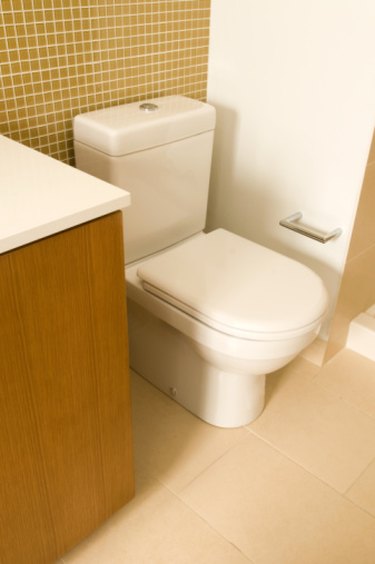
Clogged toilets are frustrating to unclog. Homeowners possessing only one bathroom are especially at a disadvantage as they are without a facility while attempting to rid the toilet of the clog. Store-bought chemicals can be poured into the toilet to dissolve the clog, but home remedies are often less damaging to the environment and can usually be found in the home pantry.
White Vinegar
Video of the Day
Vinegar is a by-product of the fermentation process of grain alcohol. Vinegar is a food additive, a natural antiseptic and an all-purpose cleaner. Mixing vinegar with baking soda can break up toilet clogs. Begin by plunging your toilet to see if you can loosen the clog. If you have a plumber's snake, inserting it into the toilet can sometimes push the clogged material through. Pour 1/2 to 1 cup of baking soda into the toilet bowl and then add 1/2 cup white vinegar. Allow the vinegar and baking soda to work on the clog for about 10 to 15 minutes. Boil two quarts of water while you are waiting. Pour the boiled water into the toilet and flush the toilet. If the clog persists, re-plunge and repeat the process. It may be necessary to remove some toilet water into a bucket for disposal.
Video of the Day
Bleach
Laundry bleach is a powerful cleaner. Bleach, in conjunction with soap powder and a plunger can break up a toilet clog. The bowl should be about half full of water. Add tap water if necessary. Pour 3 cups of bleach into the bowl. Add 1 cup of soap powder to the toilet water. Soap powder is also called washing powder, sodium carbonate, soda ash or washing soda and is available through grocery, discount and many online stores. It is not the same thing as powdered laundry detergent. Allow the bleach and soap powder to dissolve the clog. In the book, "Recipes for Home Repair," as featured on the Accurate Building Inspectors website, the authors recommend smearing petroleum jelly around the bottom edge of a plunger while the bleach is working in the toilet. Place the plunger into the toilet as usual and forcefully plunge the toilet. The jelly forms a tight seal during the plunging. Flush the toilet. Repeat the process until the toilet is functioning properly.
Salt Water
Plunge the toilet before beginning to see if the clog will move. If you have a plumber's snake, feeding it into the toilet may loosen or disperse the clog. If you don't have a plumber's snake, substitute a straightened coat hanger. For stubborn clogs, mix 1 cup salt with 1 gallon boiling water and pour into the toilet bowl. For frequent clogs caused by tree root invasion into older plumbing pipes, pour 1 cup of rock salt into the toilet, followed by a kettle (about 2 quarts) of boiling water. Repeat the salt and water application every two weeks. Salt will kill the small invasive tree roots but won't harm the tree itself.
Boiling Water
Pour 2 quarts boiling water into the toilet bowl and allow the water to permeate the clog for about five minutes. Pour 1 cup of powder or liquid dishwasher detergent into the toilet and allow it to permeate the clog for another five minutes. Plunge the toilet as usual. Liquid dish detergent containing a grease fighting agent is also effective on clogs. Flush the toilet. Repeat the process if necessary, taking care not to splash yourself with the hot water, until the clog moves through the pipe and the toilet flushes normally.
- Official Website of the City of Boston: Safe Cleaning for People with Asthma
- Accurate Building Inspectors; “Recipes for Home Repair”; How To UnClog A Toilet Bowl; Alvin Ubell, et al.; 2005
- The Complete Idiot's Guide to Household Solutions; Melodie Moore; 1998
- USA Plumbing; How to Unclog a Toilet Using a Plunger or Auger; 2011